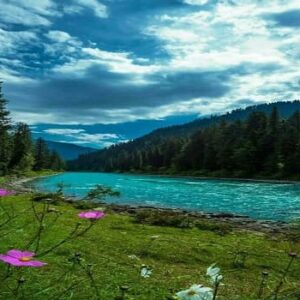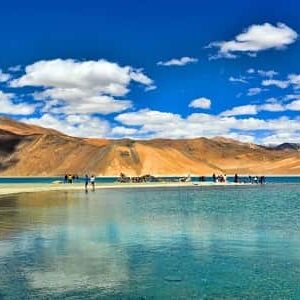The Shanti Stupa in Leh is a prominent Buddhist monument located in the town of Leh in the Ladakh region of northern India. It is a white-domed stupa (a type of Buddhist monument) that stands on a hilltop and offers panoramic views of the surrounding Himalayan mountains and the town of Leh. Here are some key details about the Shanti Stupa:
The Shanti Stupa was built with the primary objective of promoting peace and prosperity in the region and in the world. It is a symbol of Buddhism’s message of non-violence and harmony.
The stupa was constructed by a Japanese Buddhist organization known as the “Japanese for World Peace” to commemorate 2,500 years of Buddhism. The construction was completed in 1991, and it was inaugurated by the 14th Dalai Lama, Tenzin Gyatso.
The Shanti Stupa is not only a place of worship but also a symbol of peace and a popular tourist destination in Leh, offering stunning views of the Ladakh region. It embodies the essence of Buddhism and its message of harmony and non-violence.
Table of Contents
ToggleShanti Stupa Overview
The Shanti Stupa in Leh, an oasis of serenity amidst the rugged Himalayan terrain, stands as a unique testament to the universal pursuit of peace and spirituality. This striking white-domed stupa, perched majestically on a hilltop, transcends boundaries, fostering harmony beyond its spiritual significance.
What sets the Shanti Stupa apart is its remarkable history and purpose. In 1991, the stupa was meticulously constructed by the “Japanese for World Peace,” a Japanese Buddhist organization, to commemorate 2,500 years of Buddhism. Its inception, a harmonious blend of Indian and Japanese culture, symbolizes the enduring global appeal of Buddhism, resonating with all who seek solace and tranquility.
The stupa’s architecture is a captivating fusion of Japanese design principles and Ladakhi aesthetics. Its pristine white structure, adorned with intricate engravings and crowned with golden spires, glistens brilliantly under the azure Ladakhi sky. Within the stupa lie precious relics and sacred Buddhist imagery, evoking a sense of profound spirituality.
Positioned on a precipitous hill in the Changspa region, the Shanti Stupa offers a panorama that defies description. As the sun casts its final rays upon the arid Ladakhi landscape, the stupa’s elevated vantage point reveals an ethereal tableau: Leh town sprawled below, the meandering Indus Valley, and the rugged, snow-clad peaks of the Himalayas. It’s as if the Shanti Stupa itself stands as a sentinel, watching over and blessing the land.
Best Time to visit Shanti Stupa
The best time to visit the Shanti Stupa in Leh, Ladakh, largely depends on your preferences and the kind of experience you seek. Ladakh’s climate is characterized by extremes, and each season offers a distinct charm:
Summer (May to September): This is the peak tourist season in Ladakh and, consequently, the best time to visit the Shanti Stupa. During these months, the weather is relatively warm and pleasant, with daytime temperatures ranging from 15°C to 30°C (59°F to 86°F). The roads leading to Leh are open, making it accessible by road. You’ll enjoy clear skies, greenery, and the opportunity to engage in various outdoor activities, such as trekking and sightseeing.
Monsoon (July and August): Ladakh experiences minimal rainfall, but some sporadic showers can occur during these months. While the landscape becomes more vibrant due to the occasional rain, the roads might get muddy, and there’s a slight risk of landslides. It’s generally a good time for photography enthusiasts, but be prepared for travel disruptions.
Autumn (September to October): If you prefer fewer crowds and pleasant weather, early autumn is a fantastic time to visit. The temperatures begin to cool down, and the landscapes are still lush from the monsoon. The weather remains clear and comfortable for outdoor activities. However, as the season progresses, temperatures can drop rapidly, so plan accordingly.
How to Reach Shnati Stupa
Reaching the Shanti Stupa in Leh, Ladakh, involves traveling to Leh, the capital of Ladakh, and then making your way to the stupa. Leh is well-connected to major Indian cities by air, and you can also reach it by road if you’re coming from nearby areas like Srinagar or Manali. Here are the primary modes of transportation to reach the Shanti Stupa:
By Air:
- Flights to Leh: The easiest and most common way to reach Leh is by taking a flight to Kushok Bakula Rimpochee Airport (IXL), Leh. This airport is well-connected to major Indian cities like Delhi, Mumbai, and Srinagar. Flight schedules can vary depending on the season, so it’s advisable to check and book your flights in advance.
By Road:
From Srinagar: If you’re traveling from Srinagar, you can take the scenic Srinagar-Leh Highway (National Highway 1D), which is open from late spring to early autumn (usually from May to September, depending on weather conditions). The journey offers breathtaking views of the Himalayas and takes you through high mountain passes like Zoji La and Fotu




